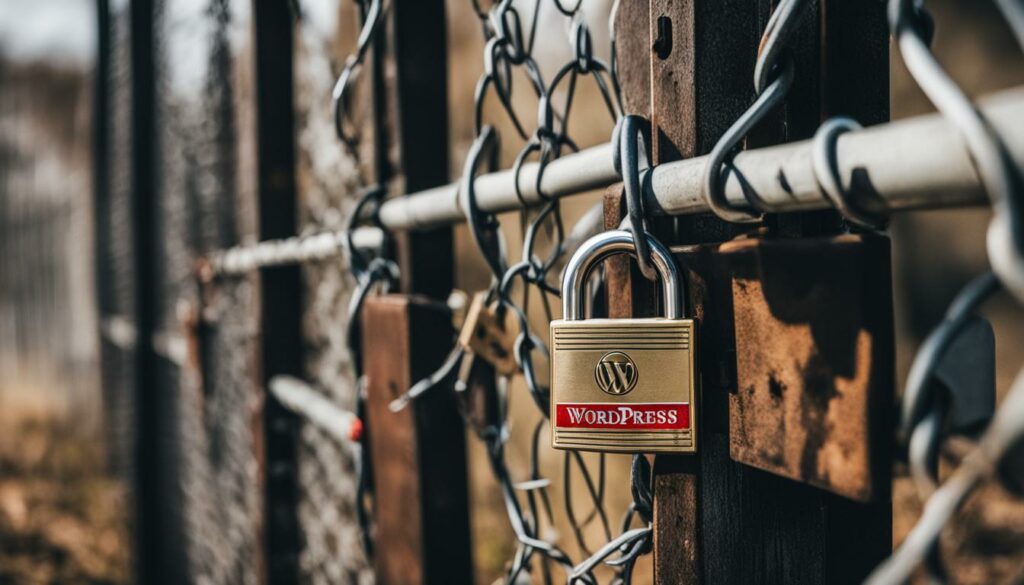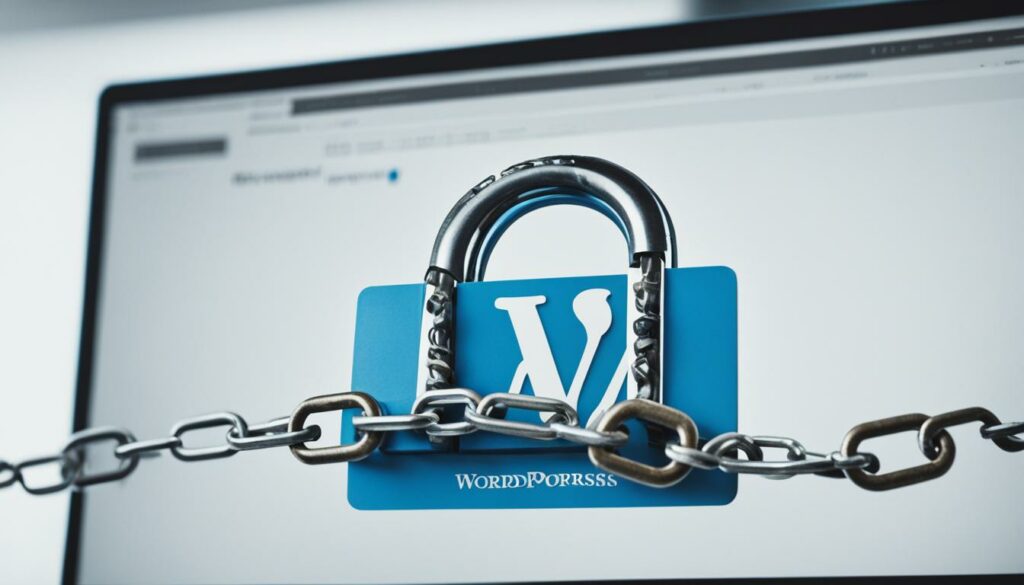Welcome to our guide on securing your WordPress site. In today’s digital landscape, website security is more important than ever. Every day, thousands of websites are blacklisted by search engines due to malware and phishing attacks. Protecting your WordPress site from hackers and malware is essential to maintain its integrity and keep your visitors safe.
At BoostedHost, we understand the criticality of website security. That’s why we recommend WordPress Hosting from BoostedHost for optimal performance and comprehensive security features. Sign up now through this link: www.boostedhost.com/wordpress-hosting.
Key Takeaways:
- WordPress security is crucial to protect your website from hackers and malware.
- Regularly updating WordPress core, themes, and plugins reduces vulnerabilities.
- Using strong passwords and controlling user permissions enhances security.
- Choosing a reputable web hosting provider is vital for overall website security.
- Easy steps, such as installing security plugins and enabling a web application firewall, can significantly improve your WordPress site’s security.
Why WordPress Security is Important?
Ensuring WordPress security is crucial to safeguard your site and protect sensitive information. Security breaches can lead to reputational damage, data leaks, and financial loss. Customers expect secure websites, and search engines favor secure sites. Therefore, it is vital to prioritize WordPress security measures.
“Website security should never be an afterthought. It’s an ongoing process that requires continuous attention and proactive measures.”
When your WordPress site is secure, you gain several benefits:
- Customer Trust: Secure websites build trust with visitors and customers. They feel confident in sharing their personal information and making transactions on a secure platform.
- Improved Search Rankings: Search engines prioritize secure websites in their search results, ensuring higher visibility and organic traffic.
- Data Protection: WordPress security measures shield sensitive data, such as customer details and financial information, from falling into the wrong hands.
- Reputation Management: A hacked or compromised website can result in tarnished brand reputation and loss of customer trust. Prioritizing website security helps protect your brand image.
Implementing WordPress security measures may seem daunting, but it’s a necessary step to protect your site and maintain the trust of your visitors and customers. In the following sections, we will explore various strategies, tools, and best practices to secure your WordPress website.
| WordPress Security Best Practices | Description |
|---|---|
| Regularly update WordPress, themes, and plugins | Keeping your WordPress core, themes, and plugins up to date ensures that security vulnerabilities are patched and minimized. |
| Use strong and unique passwords | Creating strong and unique passwords for all your WordPress accounts adds an additional layer of protection against brute-force attacks. |
| Limit user permissions | Granting only the necessary permissions to users and limiting access to the admin account helps prevent unauthorized access to your site. |
| Choose a reputable web hosting provider | Selecting a reliable hosting provider that prioritizes security can prevent common threats and keep your website safe. |
| Utilize security plugins | Implementing security plugins provides an additional layer of security by continuously monitoring and protecting your WordPress site. |
| Perform regular malware and vulnerability scans | Scanning your website for malware and vulnerabilities helps identify any security issues and allows you to take prompt action. |
By following these best practices, you can significantly enhance the security of your WordPress website and protect it from various threats.
Remember, securing your WordPress site involves a multi-faceted approach, combining technical measures with regular maintenance and user awareness. In the next sections, we will dive deeper into each aspect of WordPress security and provide step-by-step instructions on how to implement and strengthen your website’s security.
Keeping WordPress Updated
Regularly updating the WordPress core, themes, and plugins is essential for ensuring the security of your website. Outdated software can expose vulnerabilities that hackers can exploit, compromising the integrity of your site and the safety of your visitors.
WordPress provides automatic updates for minor releases, which include bug fixes and security patches. However, major updates that include new features and significant changes require manual initiation. It is important to stay vigilant and keep your WordPress site up to date to reduce the risk of security breaches.
By regularly updating WordPress, you enhance the overall security and stability of your website, providing a robust defense against potential threats and vulnerabilities.
BoostedHost offers reliable WordPress hosting services that can assist you in maintaining the security of your website. Their optimized hosting packages are specifically designed to support WordPress sites and ensure optimal performance and security. Sign up now through this link for an enhanced WordPress hosting experience.

Why is updating WordPress important for website security?
Updating WordPress regularly is crucial for website security due to the following reasons:
- Security patches: Updates often include patches that address and fix known vulnerabilities in the WordPress core, themes, and plugins.
- Compatibility: Updates ensure compatibility with the latest versions of web browsers, server software, and third-party integrations, reducing the risk of potential security loopholes.
- Improved features: Major updates often introduce new security features and enhancements that enhance the overall security posture of your website.
Keeping your WordPress site up to date is like having a solid lock on the front door of your house. It acts as a deterrent for potential hackers and provides peace of mind knowing that you have taken proactive measures to protect your online presence.
Passwords and User Permissions
When it comes to WordPress security, one of the fundamental aspects that cannot be overlooked is the strength of your passwords and user permissions. In this section, we will delve into the importance of using strong passwords, managing them effectively, and understanding user roles in WordPress.
Creating Strong Passwords
To protect your WordPress accounts from unauthorized access, it is crucial to create strong and unique passwords. Avoid using common passwords or personal information that can be easily guessed. Instead, follow these best practices:
- Use a combination of uppercase and lowercase letters, numbers, and special characters.
- Make your passwords at least 12 characters long.
- Avoid using dictionary words or consecutive numbers.
- Regularly update your passwords for added security.

Managing Passwords with a Password Manager
Keeping track of multiple complex passwords can be challenging. Fortunately, password managers can help simplify this task. A password manager securely stores all your passwords in an encrypted vault, allowing you to access them with a single master password. Additionally, password managers can generate strong passwords for you, eliminating the need to come up with them manually.
User Roles and Permissions in WordPress
WordPress offers different user roles, each with specific permissions for accessing and managing various aspects of your website. Understanding these user roles is essential for maintaining the security of your site. Here are the primary user roles in WordPress:
| Role | Capabilities |
|---|---|
| Administrator | Has full control over the WordPress site, including user management, content creation, and site settings. |
| Editor | Can publish, edit, and delete posts and pages. |
| Author | Can create and publish their own posts. |
| Contributor | Can write and submit posts for review, but cannot publish them. |
| Subscriber | Can only manage their profile and leave comments. |
It is important to assign user roles carefully, granting only the necessary permissions to each user. Limiting access to the admin account and assigning appropriate roles to other users reduces the risk of unauthorized access and potential security breaches.
The Role of Web Hosting
Your choice of web hosting provider plays a crucial role in ensuring the security of your website. When it comes to WordPress, selecting the right hosting provider can make all the difference in keeping your site safe from potential threats and attacks.
At BoostedHost, we understand the importance of website security. That’s why we offer specialized WordPress hosting services designed to provide you with a secure hosting environment for your WordPress site. Our hosting platform is optimized to deliver superior performance and robust security measures.
When you choose BoostedHost for your WordPress hosting needs, you can rest assured that your website’s security is our top priority. We implement measures such as DDoS protection, regular software updates, and advanced firewall configurations to safeguard your website from common online threats.
The Benefits of Managed WordPress Hosting
One of the most effective ways to enhance the security of your WordPress site is by opting for managed WordPress hosting. With managed hosting, you can focus on running your business while our experts take care of the technical aspects of managing and securing your website.
Here are some key benefits of managed WordPress hosting:
- Automatic Backups: Our managed hosting includes automatic daily backups of your website’s files and database. This ensures that you always have a recent copy of your site that can be quickly restored in case of any unexpected events.
- Enhanced Security Configurations: We apply advanced security configurations to your website, including malware scanning and removal, to keep your site protected from potential threats.
- Effortless WordPress Updates: We handle all WordPress core, theme, and plugin updates on your behalf, ensuring that your site is always running on the latest, most secure versions.
With BoostedHost’s managed WordPress hosting, you can enjoy the peace of mind that comes with knowing your website is in safe hands. Our team of experts is available 24/7 to assist you with any security-related concerns or technical issues that may arise.
| BoostedHost’s Managed WordPress Hosting Features: | |
|---|---|
| Automatic backups | ✓ |
| Enhanced security configurations | ✓ |
| Effortless WordPress updates | ✓ |
| 24/7 expert support | ✓ |
A secure hosting environment is crucial for mitigating the risk of data breaches, protecting sensitive user information, and maintaining the integrity and reputation of your website. Trust BoostedHost for reliable, secure WordPress hosting that puts your website’s security first.
Sign up now for BoostedHost’s WordPress hosting services and enjoy the peace of mind that comes with a secure hosting environment. Visit www.boostedhost.com/wordpress-hosting to get started.
WordPress Security in Easy Steps (No Coding)
Improving WordPress security is essential for protecting your website and ensuring the safety of your data. While it may seem intimidating, you don’t need advanced technical skills to enhance your WordPress security. In this section, we’ll guide you through simple and effective steps to secure your WordPress site without any coding knowledge. Let’s get started!
1. Install a Backup Solution:
Backing up your WordPress site regularly is crucial in case of any security breaches or accidents. It allows you to restore your site to a previous state with ease. Install a reliable backup plugin like UpdraftPlus or BackupBuddy, which automates the backup process and ensures your data is safe.
2. Use a Security Plugin:
To fortify your WordPress security, install a dedicated security plugin like Sucuri or Wordfence. These plugins offer a range of security features such as firewall protection, malware scanning, and login security. They help detect and prevent potential threats, keeping your website secure and safeguarding sensitive information.
3. Enable a Web Application Firewall (WAF):
A Web Application Firewall (WAF) acts as a shield between your WordPress site and potential hackers, blocking suspicious traffic and malicious requests. Cloud-based WAF providers like Cloudflare and Sucuri offer easy-to-use solutions that require no coding skills. By enabling a WAF, you add an extra layer of protection to your website.
4. Move to SSL/HTTPS:
Securing the connection between your users and your website is vital. Implementing an SSL certificate and migrating your site to HTTPS encrypts the data transmitted between your visitors’ browsers and your site, preventing unauthorized access. Most hosting providers offer simple one-click installations for SSL certificates, making it a hassle-free process.
By following these easy WordPress security steps, you can significantly enhance the security of your website and protect it from potential threats. Remember, prioritizing website security is essential to gain the trust of your visitors and maintain the reputation of your WordPress site.

| Plugin | Key Features | Price |
|—————————–|—————————————-|————————|
| UpdraftPlus | Automated backups | Free (Premium version available) |
| BackupBuddy | Complete site backups | Starts at $80/year |
| Sucuri | Firewall protection, malware scanning | Starts at $199.99/year |
| Wordfence | Firewall, malware scanning, login security | Free (Premium version available) |
| Cloudflare | Web Application Firewall (WAF) | Free (Premium plans available) |
Choosing the right combination of security tools based on your specific needs will work wonders for your WordPress site’s security. Don’t compromise on your website’s safety, start implementing these easy steps today!
Scanning WordPress for Malware and Vulnerabilities
Regularly scanning your WordPress site for malware and vulnerabilities is crucial for early detection and prevention of security breaches. By regularly checking for malicious code and potential weaknesses, you can proactively protect your website and ensure its continued functionality and security.
There are various tools and plugins available to help you scan your WordPress site for malware and vulnerabilities. These tools will thoroughly analyze your website and identify any potential threats or weaknesses that could be exploited by hackers.
One recommended tool is Akismet, a popular WordPress plugin that provides advanced security features, such as real-time malware scanning and automatic spam protection. Akismet uses algorithms and a global database to detect and prevent malicious activity on your website.
Implementing a malware scanning tool like Akismet can significantly enhance your website’s security and safeguard your online presence.
Another effective tool for vulnerability scanning is Wordfence Security. This plugin offers a comprehensive suite of security features, including malware scanning, firewall protection, and login security. Wordfence Security also provides real-time threat intelligence, helping you stay informed about the latest security risks and vulnerabilities.
When scanning your WordPress site for vulnerabilities, it’s essential to consider both the front-end and back-end aspects of your website. Vulnerabilities can exist in various areas, such as outdated plugins, weak passwords, or insecure file permissions.
Here are some best practices to keep in mind when scanning for vulnerabilities:
- Regularly update your WordPress core, themes, and plugins to patch any security vulnerabilities.
- Use strong and unique passwords for all WordPress accounts to prevent unauthorized access.
- Monitor file and directory permissions to ensure they are set correctly and restrict access to sensitive areas of your website.
- Review user permissions and roles to ensure that each user has appropriate access levels and privileges.
Scanning your WordPress site for malware and vulnerabilities is an essential step in protecting your website and valuable data from potential threats. By utilizing reliable scanning tools and following best practices, you can enhance your website’s security and minimize the risk of hacking and data breaches.
Next, we will discuss the steps to take if your WordPress site gets hacked and provide guidance on malware removal and website recovery.
Fixing a Hacked WordPress Site
Discovering that your WordPress site has been hacked can be devastating. However, with immediate action and the right steps, you can minimize damage, remove malware, and restore website security. Follow the guide below to fix a hacked WordPress site and ensure a smooth recovery process:
1. Identify the Hacked Site
Symptoms of a hacked WordPress site can include unexpected redirects, unusual pop-ups, or a sudden drop in search engine rankings. Additionally, if you encounter a warning message from a security plugin or Google, it could indicate a compromised website. Monitor your site closely for any signs of suspicious activity or unexpected changes.
2. Take Immediate Action
As soon as you suspect a hacked site, take the following immediate actions:
- Isolate the site: Disconnect your website from the network by disabling any plugins or themes you suspect may have been compromised.
- Change passwords: Reset all passwords associated with your WordPress site, including admin accounts, FTP, and database access. Ensure that you use strong, unique passwords.
- Notify your hosting provider: Inform your hosting provider about the security breach. They can assist you in identifying the source of the attack and provide guidance on resolving the issue.
3. Remove Malware
Removing malware from a hacked WordPress site is critical to restoring its security. These steps can help you accomplish that:
- Scan your site: Utilize reliable security plugins or online malware scanners to detect malicious code or infected files.
- Quarantine infected files: Isolate any identified malware or compromised files to prevent them from affecting other parts of your WordPress site.
- Restore clean backups: If you have clean backups, restore them after ensuring they are free from malware. Be cautious not to restore infected files.
- Manually remove malware: If automated methods are unable to remove all traces of malware, manual removal may be necessary. This involves identifying and deleting suspicious files or code snippets.
4. Recover and Secure Your Website
After removing malware, recover and secure your WordPress site with the following steps:
- Update WordPress and plugins: Ensure that your WordPress core, themes, and plugins are up to date. This helps fix any vulnerabilities that the hackers may have exploited.
- Strengthen security measures: Use security plugins and implement additional security measures such as two-factor authentication, captcha, and IP whitelisting.
- Monitor your site: Regularly scan your site for any suspicious activity or signs of a breach. Implement a website monitoring service to receive alerts for any potential security issues.
Remember, securing your WordPress site is an ongoing process. Stay vigilant and maintain a proactive approach to website security.
For optimal performance and robust security, we recommend WordPress hosting from BoostedHost. Sign up now through this link.
| Pros | Cons |
|---|---|
| Provides greater control over the removal process | Requires technical expertise |
| Economical for small-scale websites | Time-consuming, especially for larger sites |
| Can ensure complete removal of malware | Potential for accidental deletion of important files |
Conclusion
Securing your WordPress site is crucial for maintaining the integrity and trustworthiness of your online presence. By implementing comprehensive WordPress security strategies, you can protect your website from potential vulnerabilities and malicious attacks. Remember, a proactive approach to security is always better than reactive measures.
To enhance the security of your WordPress website, follow these important steps:
- Keep your WordPress core, themes, and plugins up to date. Regular updates ensure that you have the latest security patches and fixes.
- Create strong, unique passwords for all WordPress accounts and limit access permissions to prevent unauthorized entry.
- Select a reliable and reputable web hosting provider, such as BoostedHost, that prioritizes website security and offers robust protection against common threats.
- Utilize security plugins and tools to add an extra layer of defense to your WordPress site. These tools can help detect and prevent security breaches.
By implementing these strategies, you can significantly mitigate the risk of your WordPress site being compromised. Protecting your website not only safeguards your valuable data but also maintains the trust of your visitors and customers. Start prioritizing WordPress security today to ensure a secure and reliable online presence.
FAQ
Q: Why is website security important for WordPress?
A: Website security is crucial for WordPress because it helps protect your site from potential threats such as hackers, malware, and phishing attacks. A secure website ensures the safety of your sensitive information, prevents reputational damage, data leaks, and financial loss.
Q: How can I keep my WordPress site updated?
A: To keep your WordPress site updated, regularly check for and install updates for WordPress core, themes, and plugins. WordPress provides automatic minor updates, while major updates require manual initiation. Keeping your site up to date reduces the risk of security breaches.
Q: What should I do to ensure strong passwords and user permissions?
A: To ensure strong passwords, use complex and unique passwords for all WordPress accounts, including admin, FTP, and database. It’s recommended to manage passwords with a password manager. Additionally, limit access to the admin account and understand user roles and permissions in WordPress.
Q: How does web hosting affect website security?
A: Your choice of web hosting provider plays a crucial role in website security. It’s important to choose a reputable hosting provider that implements measures to protect their servers from common threats, such as DDoS attacks. Managed WordPress hosting offers additional security features, including automatic backups and advanced configurations.
Q: Are there easy steps to improve WordPress security without coding?
A: Yes, there are steps you can take to improve WordPress security without coding. These include installing a backup solution, using a security plugin, enabling a web application firewall, and moving to SSL/HTTPS. These measures can significantly enhance the security of your WordPress site.
Q: How can I scan my WordPress site for malware and vulnerabilities?
A: Regularly scanning your WordPress site for malware and vulnerabilities is crucial. You can use various tools and plugins to scan your site for malicious code and potential vulnerabilities. These tools help with early detection and prevention of security breaches.
Q: What can I do if my WordPress site gets hacked?
A: If you discover that your WordPress site has been hacked, it’s important to take immediate action. This includes identifying the hacked site, removing malware, and going through the process of recovering and securing your website. Minimizing damage and restoring site functionality is essential.












